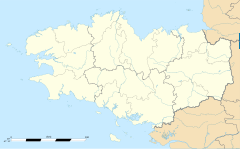| Pleumeur-Bodou Ground Station | |
|---|---|
 Earth receiving dishes in 2008 | |
| General information | |
| Type | Earth station |
| Location | Pleumeur-Bodou, Brittany |
| Coordinates | 48°47′06″N3°31′26″W / 48.785°N 3.524°W |
| Construction started | 1961 |
| Completed | 1962 |
Pleumeur-Bodou Ground Station was an early ground station in north-west France, and one of the first in the world. It was the site of the first satellite transmission between the US and Europe in the early morning of 11 July 1962 (French time), lasting 19 minutes on the satellite's seventh orbit. [1]
